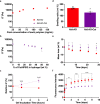Preventing post-surgical cardiac adhesions with a catechol-functionalized oxime hydrogel
- PMID: 34145265
- PMCID: PMC8213776
- DOI: 10.1038/s41467-021-24104-w
Preventing post-surgical cardiac adhesions with a catechol-functionalized oxime hydrogel
Abstract
Post-surgical cardiac adhesions represent a significant problem during routine cardiothoracic procedures. This fibrous tissue can impair heart function and inhibit surgical access in reoperation procedures. Here, we propose a hydrogel barrier composed of oxime crosslinked poly(ethylene glycol) (PEG) with the inclusion of a catechol (Cat) group to improve retention on the heart for pericardial adhesion prevention. This three component system is comprised of aldehyde (Ald), aminooxy (AO), and Cat functionalized PEG mixed to form the final gel (Ald-AO-Cat). Ald-AO-Cat has favorable mechanical properties, degradation kinetics, and minimal swelling, as well as superior tissue retention compared to an initial Ald-AO gel formulation. We show that the material is cytocompatible, resists cell adhesion, and led to a reduction in the severity of adhesions in an in vivo rat model. We further show feasibility in a pilot porcine study. The Ald-AO-Cat hydrogel barrier may therefore serve as a promising solution for preventing post-surgical cardiac adhesions.
Conflict of interest statement
K.L.C. is co-founder, consultant, and holds equity interest and M.M.M. is a consultant for Karios Technologies, Inc. M.F., M.M.M., and K.L.C. are inventors on patent/patent applications (US10611880B2, WO2018183284A1) related to this work. The other authors declare no competing interests.
Figures







Similar articles
-
Binding of Anticell Adhesive Oxime-Crosslinked PEG Hydrogels to Cardiac Tissues.Adv Healthc Mater. 2015 Jun 24;4(9):1327-31. doi: 10.1002/adhm.201500167. Epub 2015 May 12. Adv Healthc Mater. 2015. PMID: 25963916 Free PMC article.
-
Prevention of post-surgical abdominal adhesions by a novel biodegradable thermosensitive PECE hydrogel.BMC Biotechnol. 2010 Sep 9;10:65. doi: 10.1186/1472-6750-10-65. BMC Biotechnol. 2010. PMID: 20825683 Free PMC article.
-
Preventing postoperative abdominal adhesions in a rat model with PEG-PCL-PEG hydrogel.Int J Nanomedicine. 2012;7:547-57. doi: 10.2147/IJN.S26141. Epub 2012 Feb 2. Int J Nanomedicine. 2012. PMID: 22346350 Free PMC article.
-
Dual-Polymer Carboxymethyl Cellulose and Poly(Ethylene Oxide)-Based Gels for the Prevention of Postsurgical Adhesions.J Biomed Mater Res A. 2025 Jan;113(1):e37852. doi: 10.1002/jbm.a.37852. J Biomed Mater Res A. 2025. PMID: 39719874 Review.
-
Hydrogel, a novel therapeutic and delivery strategy, in the treatment of intrauterine adhesions.J Mater Chem B. 2021 Sep 7;9(33):6536-6552. doi: 10.1039/d1tb01005k. Epub 2021 Jul 29. J Mater Chem B. 2021. PMID: 34324619 Review.
Cited by
-
Beyond Traditional Medicine: EVs-Loaded Hydrogels as a Game Changer in Disease Therapeutics.Gels. 2024 Feb 21;10(3):162. doi: 10.3390/gels10030162. Gels. 2024. PMID: 38534580 Free PMC article. Review.
-
Chronological adhesive cardiac patch for synchronous mechanophysiological monitoring and electrocoupling therapy.Nat Commun. 2023 Oct 6;14(1):6226. doi: 10.1038/s41467-023-42008-9. Nat Commun. 2023. PMID: 37803005 Free PMC article.
-
Application of Polymer Hydrogels in the Prevention of Postoperative Adhesion: A Review.Gels. 2023 Jan 23;9(2):98. doi: 10.3390/gels9020098. Gels. 2023. PMID: 36826268 Free PMC article. Review.
-
Fast-Forming Dissolvable Redox-Responsive Hydrogels: Exploiting the Orthogonality of Thiol-Maleimide and Thiol-Disulfide Exchange Chemistry.Biomacromolecules. 2022 Sep 12;23(9):3525-3534. doi: 10.1021/acs.biomac.2c00209. Epub 2022 Jun 13. Biomacromolecules. 2022. PMID: 35696518 Free PMC article.
-
Optical mapping of cardiac electromechanics in beating in vivo hearts.Biophys J. 2023 Nov 7;122(21):4207-4219. doi: 10.1016/j.bpj.2023.09.017. Epub 2023 Sep 29. Biophys J. 2023. PMID: 37775969 Free PMC article.
References
Publication types
MeSH terms
Substances
Grants and funding
LinkOut - more resources
Full Text Sources
Medical
Miscellaneous

